Two artists — from Tijuana and El Paso — explore borders physical and theoretical
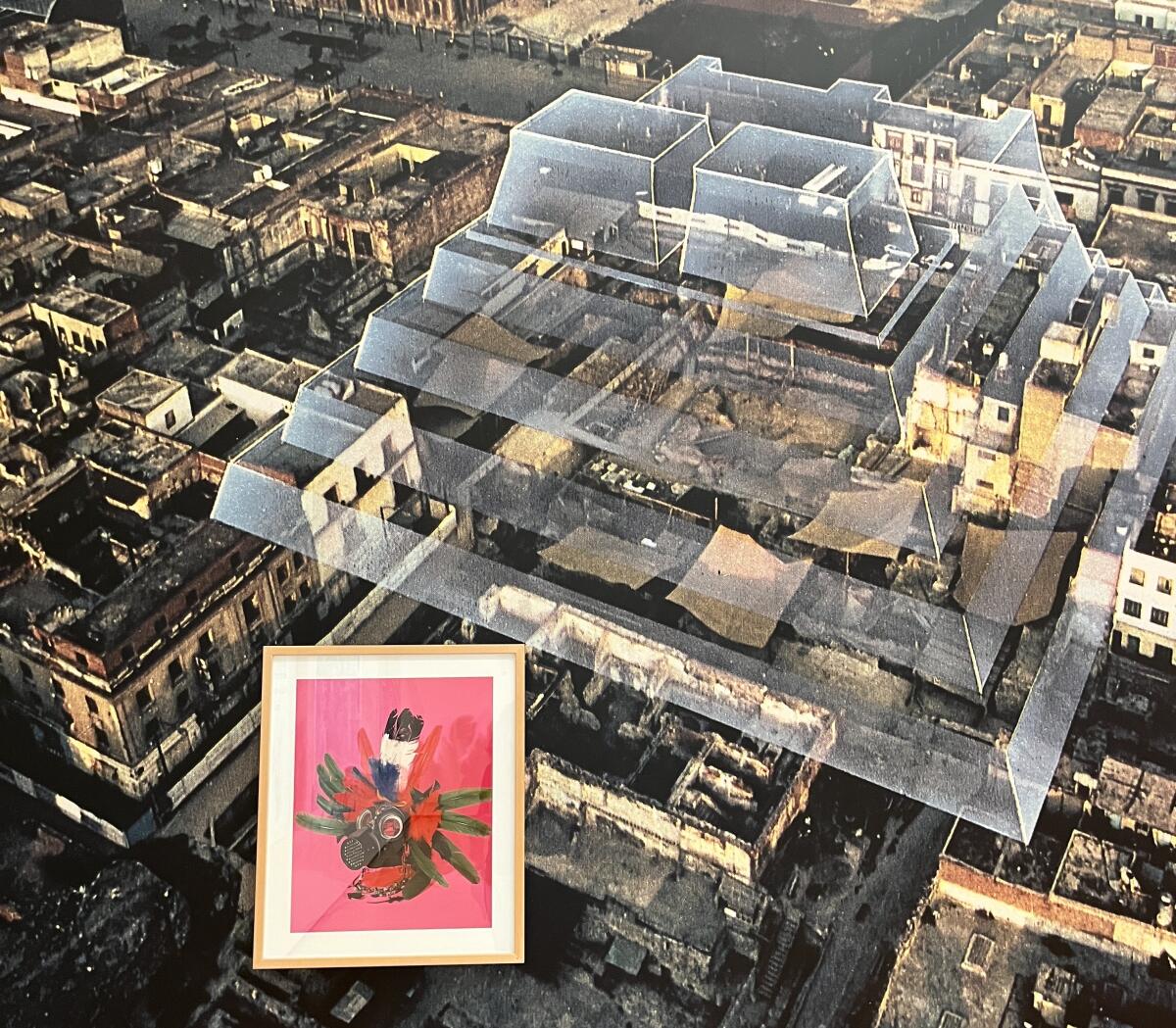
- Share via
The latest manifestation of our ongoing climate emergency in Maui has been devastating. Sending all the healing vibes to Hawaii. I’m Carolina A. Miranda, art and design columnist at the Los Angeles Times, and I’m here with the week’s culture news:
Borders / Fronteras
In 1981, artist Celia Álvarez Muñoz got up before her class in her graduate MFA program at Texas State University. Rather than deliver the assigned presentation, she began to impersonate the professor. She had big news, she announced. A major ancient Indigenous archaeological site had been uncovered in Mexico City and among the findings was an early 16th century artifact: a plumed mask depicting the deity “Petrocuatl,” which the class would have the great privilege of seeing.
Like the persona Álvarez Muñoz had created, the artifact was also an invention: a vintage gas mask she had studded with beads and feathers whose name was a portmanteau of “petrol” and “cuatl,” the Nahua word for serpent. “Petrocuatl” was not an ancient relic, but instead a playful critique of our modern lust for oil.
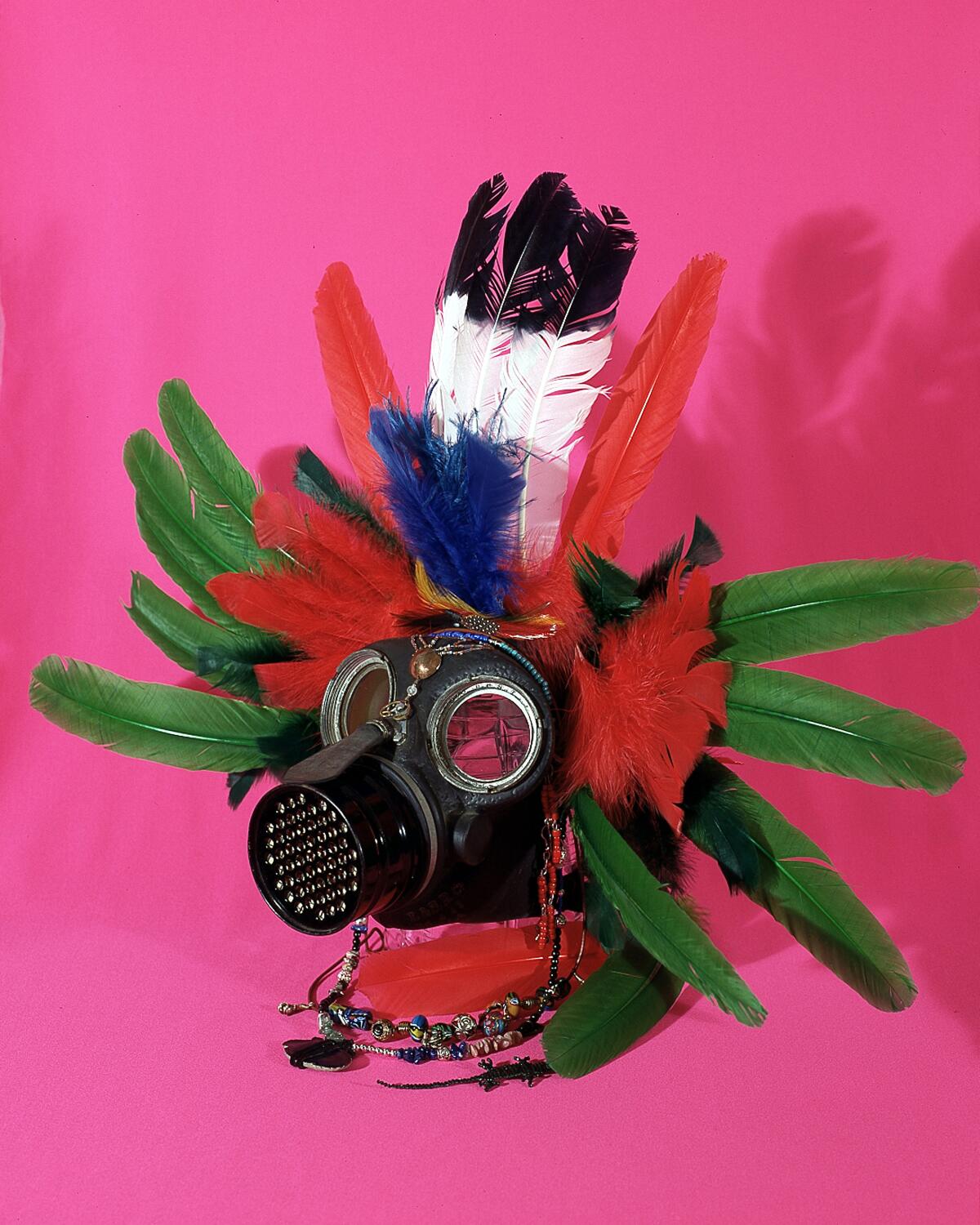
Álvarez Muñoz is an artist who likes to contar cuentos — tell stories.
Throughout her career retrospective at the La Jolla branch of the Museum of Contemporary Art San Diego — which is now in its final weekend — storytelling materializes as a critical spine of her varied practice, combining word and image in playful and pointed ways. Sequences of staged photographs or appropriated images are combined with evocative stories about beheading her grandmother’s saints or being asked to participate in an art show inside a dingy Texas motel.
Also materializing in these stories is her family’s history: the journey her grandparents made from Mexico to El Paso (where Álvarez Muñoz was born) or the trains her dad took — from those he jumped in search of work during the Great Depression to the ones that deployed him around Europe during World War II. In a large 1991 mural titled “Abriendo Tierra/Breaking Ground,” which she has recreated in the galleries at MCASD, she borrows Indigenous imagery to tell a story about storytelling.
In humorous, conceptual ways, she articulates the story — or the many stories — of growing up along the juncture of two nations, both of which she inhabits like a border Baldessari. It’s an intriguing follow-up to the Alexis Smith exhibition that was on view at the museum last fall, another show in which a woman toyed with historical and graphic clichés via object, image and text.
Make the most of L.A.
Get our guide to events and happenings in the SoCal arts scene. In your inbox every Monday and Friday morning.
You may occasionally receive promotional content from the Los Angeles Times.
It’s also one of two exhibitions by women artists from the border currently on view (only through Sunday) at MCASD. Two floors down is a solo show of recent work by Griselda Rosas, an artist from Tijuana, whose work engages storytelling in very different ways. The two artists hail from different countries, different regions of the border and different generations. (Álvarez Muñoz was born in 1937, Rosas exactly 40 years later.) Where Álvarez Muñoz uses the more oblique language of conceptualism, Rosas is preoccupied by craft.
On scraps of faux ostrich skin and pieces of plain paper, she combines painted surfaces, collaged images and layers of embroidery to reimagine — in humorous and fantastical ways — historical narratives of conquest and colonization.
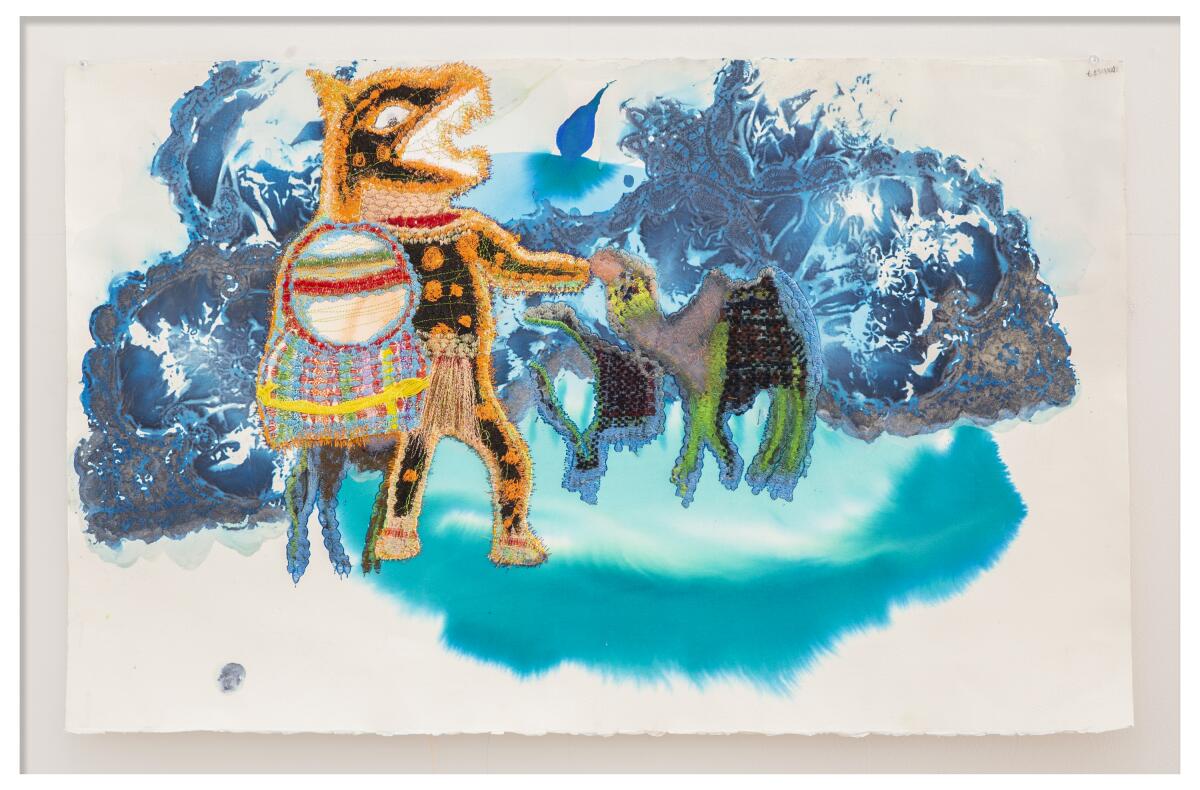
Some of the more fanciful motifs were, in part, generated by her son. (Rosas has borrowed from his drawings for her own work, as she told KPBS.) Others are drawn from the historical record: a Nahua warrior in a jaguar suit, a cactus inspired by early botanical drawings, images of the Virgen de Guadalupe materializing in a grotto crafted from hundreds of tiny stitches. These scenes read like a feverish reimagining of the crude drawings that often accompanied colonial chronicles.
Truly remarkable are her sculptures: large-scale pieces made from wood and cement that resemble giant slingshots. Look again and they could also be needles and seam rippers — the artist’s tools as weapons.

Together, both shows reveal artists engaging the border without literal depictions of fences or walls. Instead, you’ll find mordant takes on what it means, culturally and artistically, to inhabit two worlds.
“Celia Álvarez Muñoz: Breaking the Binding” and “Griselda Rosas: Yo te cuido” are on view at the Museum of Contemporary Art San Diego through Sunday; 700 Prospect St., La Jolla; mcasd.org.
Getting there: Can’t stomach the drive to San Diego? May I highly recommend the Amtrak Surfliner to Old Town San Diego, followed by an easy transfer to the MTS 30 bus, to the Pearl Street and Draper Avenue stop, which will deposit you just a few blocks from the museum.
In the galleries
The California African American Museum just reopened its doors after a $5 million refresh that includes a new HVAC system, refinished floors and weatherproofed glass ceiling panels in the atrium. But, more importantly, it features new public art (including an outdoor installation by Chloë Bass), as well as a renewed mission focused on four areas. The Times’ Deborah Vankin spoke to director Cameron Shaw about these fields: Black abstraction; Black lives/green justice; liberating the Black archive; and spirituality and ancestral technologies.

Artist Gala Porras-Kim is known for wry works that examine museum practices — collections care, acquisitions, repatriation, the presentation of ancient objects — sometimes in ways that give more visibility to their collectors than to the cultures that created them. For her ongoing exhibition at the Fowler Museum, which was organized by chief curator Matthew H. Robb, she has turned her attention to unusual items in the museum’s vaults, including an unidentified bag of crumbly detritus. Contributor Rob Goyanes digs in.
Just dance
O’Shae Sibley was stabbed to death for vogueing at a New York City gas station late last month and the suspect who killed him has been charged with a hate crime. In protest of his death, dancers affiliated with the West Coast ballroom scene danced at an L.A. gas station in tribute. Sibley’s murder comes at a moment of prominence for ballroom, but also a moment of increased anti-LGTBQ rhetoric and legislation. “People are fascinated by the movement,” performer and activist Gia Love told The Times’ Steven Vargas, “but don’t care about the people because the people are Black and brown.”

Hip-hop is turning 50 (which makes me realize I’m older than hip-hop — yiiiiiikes). In Phoenix, thousands of dancers from around the world recently competed in the World Hip Hop Dance Championship. The Times’ Jevon Phillips followed a group of teams from Pasadena led by dancer Beau Fournier.
On and off the stage
Patti Hartigan’s new book, “August Wilson: A Life,” chronicles the life and career of the venerable playwright, and Times theater critic Charles McNulty has a read. The book is “an invaluable and highly absorbing new biography,” he writes, tracing “Wilson’s groundbreaking trajectory from his penurious beginnings to his death at age 60 in 2005, which made the front pages of newspapers around the nation.”

Essential happenings
Steven Vargas guides us through everything there is to see in L.A. — from a performance by the Raiford Rogers Modern Ballet at the Luckman to Taylor Swift’s fashions at the Grammy Museum.
In last week’s newsletter, I wrote about the legacy of African blacksmiths and the incredible 2018 exhibition “Striking Iron,” organized by the Fowler Museum, which explored not just aesthetic traditions but the ways in which ironworking was central to culture, politics and spirituality in many sub-Saharan African nations. This week, I happened to catch the exhibition “African by Design: Form, Pattern and Meaning in African Craft” at the Mingei International Museum while in San Diego.
The show included some terrific examples of African metallurgy, so if you missed “Striking Iron” or simply want to see some similarly well-crafted pieces (along with some beautiful textiles), definitely pay a visit. “African by Design” is on view through Sept. 17.
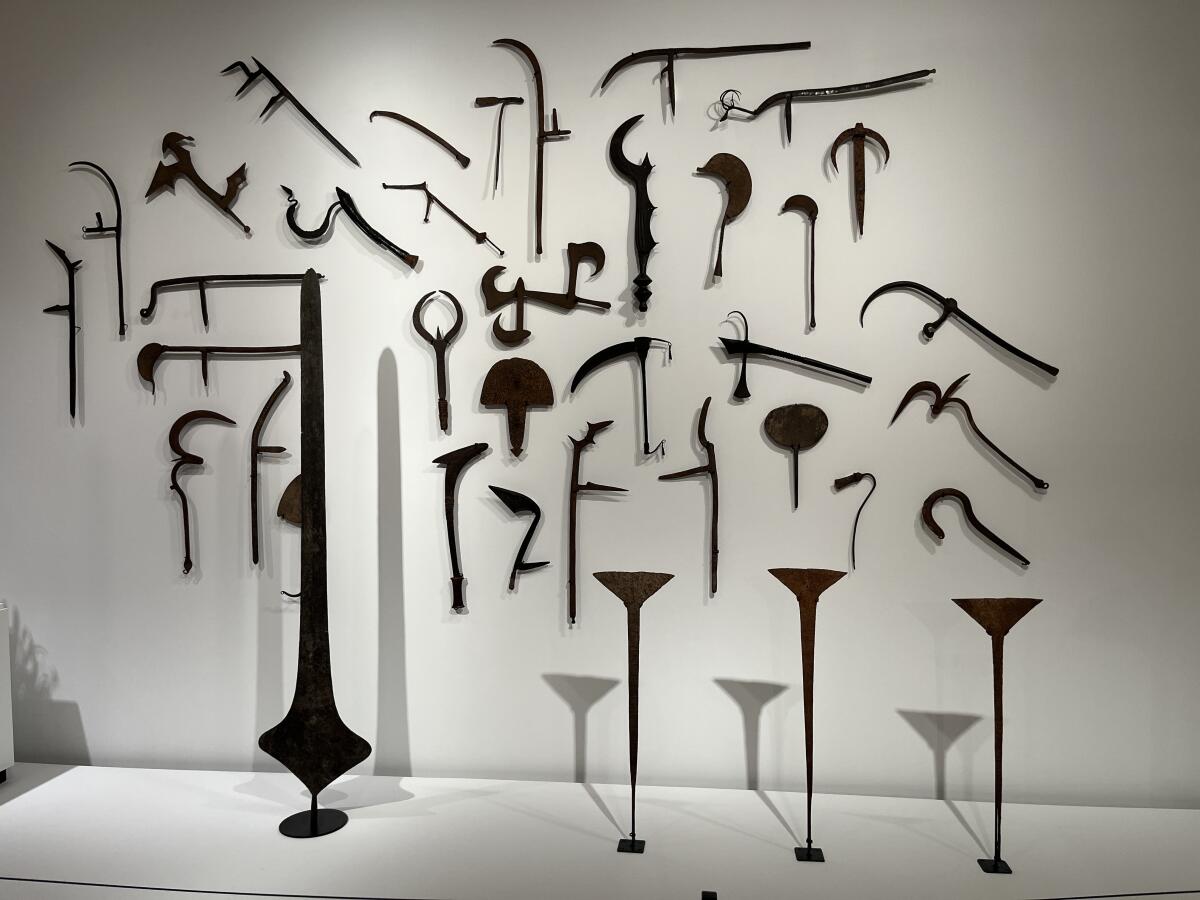
Moves
The Helen Frankenthaler Foundation’s climate initiative has announced grants to 48 organizations totaling $2.7 million to help reduce their climate impact. Among them are California cultural organizations such as SFMOMA, the California College of the Arts and CalArts.
Enjoying this newsletter? Consider subscribing to the Los Angeles Times
Your support helps us deliver the news that matters most. Become a subscriber.
The Bowers Museum has named Sean O’Harrow president and chief executive. O’Harrow replaces Peter C. Keller, who led the museum for 31 years. That announcement coincides with a $1 million donation to the museum from the Mary and John Tu Foundation.
LACMA’s technology lab has named its 2023 grant recipients. They include artists Patty Chang and David Kelley, Tristan Duke, Haleigh Nickerson and Gala Porras-Kim.
Cal State Long Beach has added a sculpture by Nancy Graves to its outdoor sculpture collection — the first addition since 1993.
Passages
Jamie Reid, the artist who helped give British punk rock its edgy, rough-hewn look, has died at 76. “It was his designs for the English punk band the Sex Pistols,” writes Jessica Gelt in his obituary, “that cemented his status as one of the progenitors of the DIY-style graphic design that came to define punk rock music in the 1970s and remains seminal to this day.”
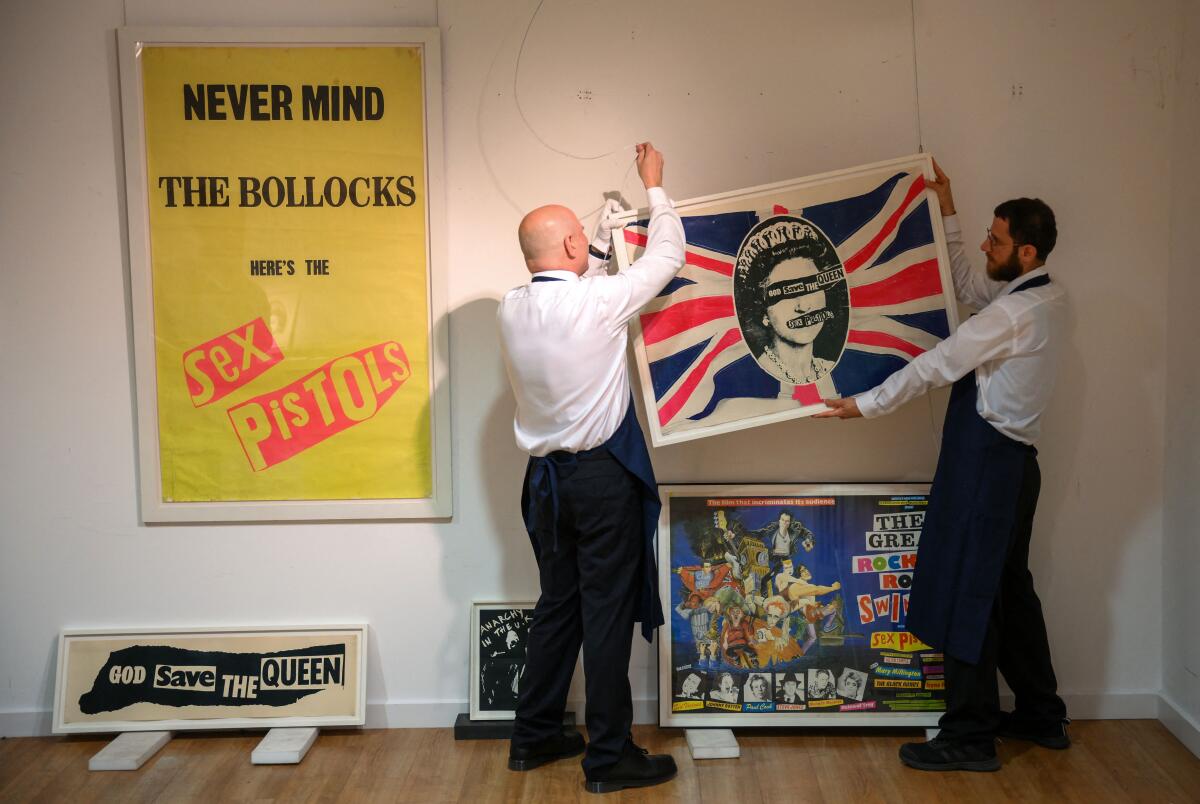
Painter Brice Marden, whose looping canvases pushed abstraction in new directions, is dead at 84.
In the news
— Myriam Gurba on the Edgar, the haircut that looks easy — but actually requires a lot of painstaking care to produce.
— Memo to NIMBYs: affordable housing is unlikely to affect your property values.
— Ukraine has launched an art market portal that catalogs works owned by Russian oligarchs — with the intent of making such works more difficult to sell.
— In addition to the staggering loss of life on Maui, the fires have also destroyed historic structures such as Lahaina’s Pioneer Inn, built in 1901.
— Workers at the Guggenheim Museum in New York have ratified their first contract.
— Artists Gary Panter and Wayne White talk about devising the “garish and glorious” Pee-wee Herman aesthetic.
— Bomb has a terrific interview with comedian, art critic and occasional Times contributor Christina Catherine Martinez.
— “A strangely ambitious yet also weirdly lazy curatorial endeavor.” A must-read from Emily Colucci on Hannah Gadsby’s “It’s Pablo-matic” at the Brooklyn Museum.
— Digging the botanical illustrations of 18th century herbalist Elizabeth Blackwell.
— A mystery piano recently showed up alongside a trail at Dimond Park in Oakland.
— A new report by the Dance Data Project shows that ballet companies have been pummeled by the pandemic, with budgets at the top 150 companies down by almost a third between fiscal year 2020 and 2021.
— Barcode scanner music is my mood.
And last but not least ...
A history of the folding chair.
The biggest entertainment stories
Get our big stories about Hollywood, film, television, music, arts, culture and more right in your inbox as soon as they publish.
You may occasionally receive promotional content from the Los Angeles Times.




